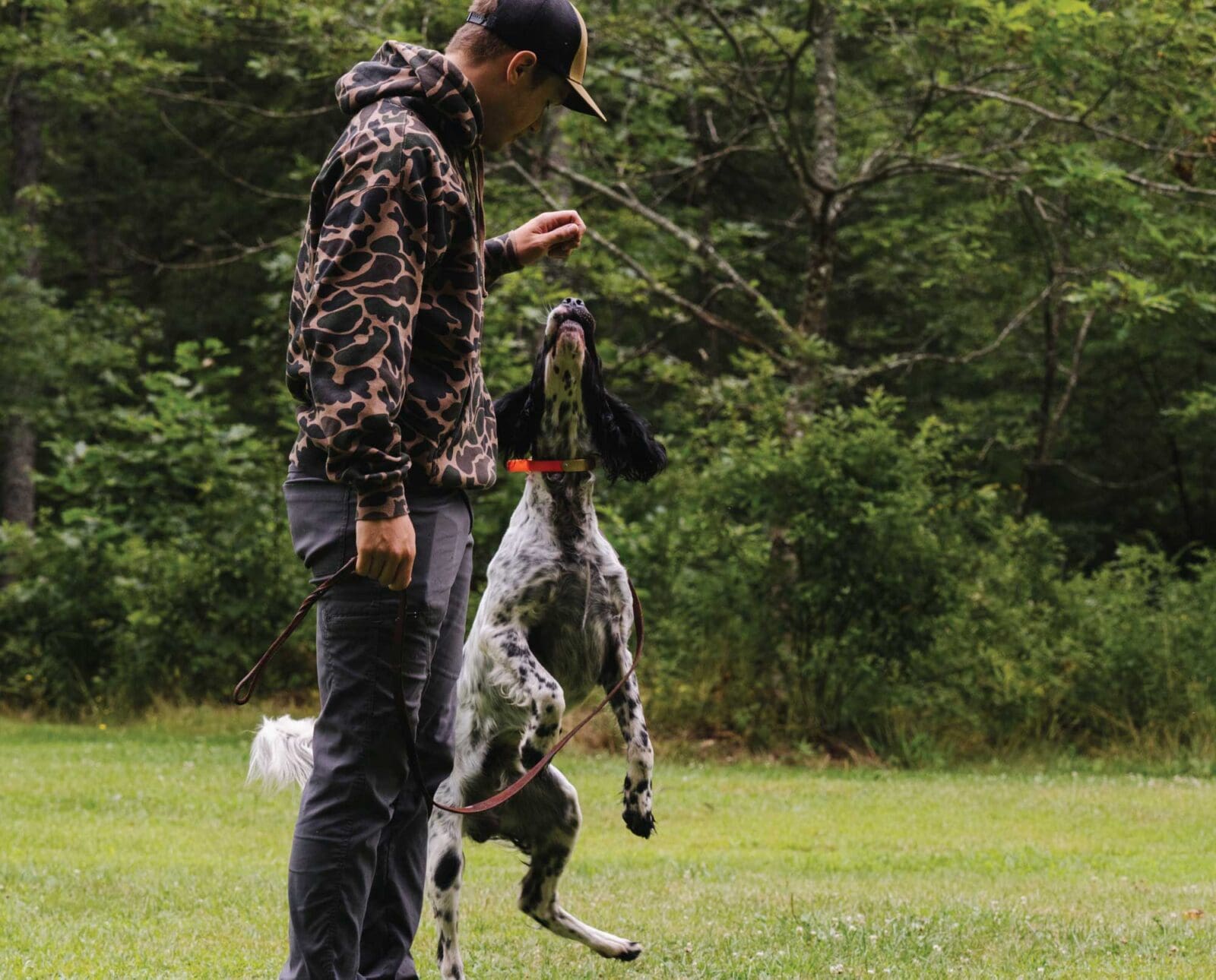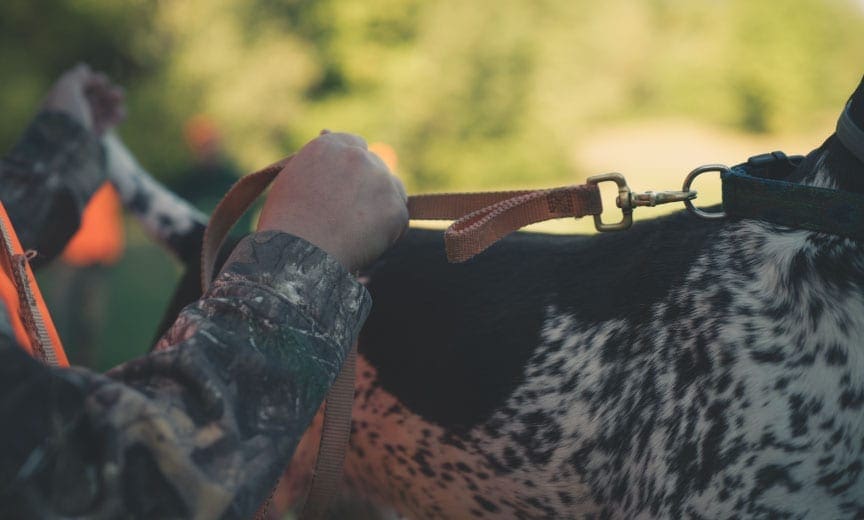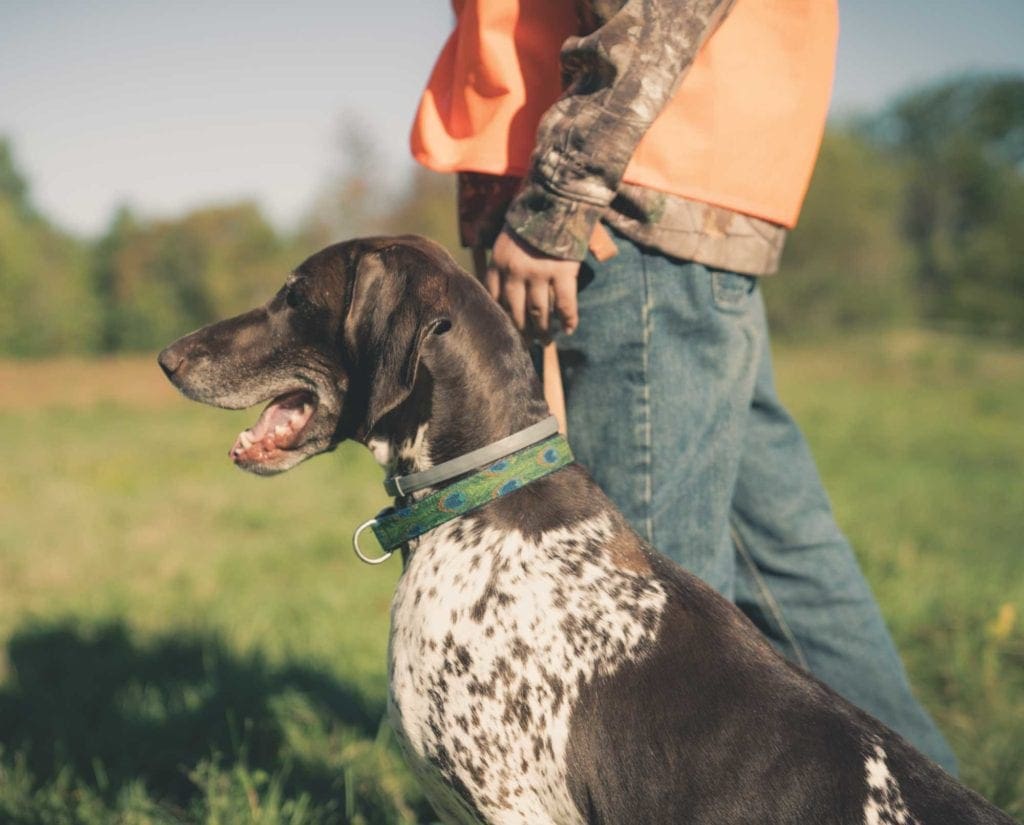Home » Hunting Dogs » The Five Mental States of Dogs in Training
The Five Mental States of Dogs in Training

Jason Carter is a NAVHDA judge, NADKC member, director of…
The mental state of you and your dog can make the difference between success and failure in dog training
“Anyone seen my dog?”
I don’t know who that dog is out there. My dog is a diva, a jerk or even an asshole. We’ve seen and heard it all over the years at Merrymeeting Kennels, from frustrated owners whose hopes and dreams have been overshadowed by their perceived training failures.
Listen to more articles on Apple | Google | Spotify | Audible
If you have ever owned and trained a hunting dog you know far too well that every dog has its day. Why suddenly is my dog starting to refuse, avoid or ignore my commands? Why does he act confused, refusing a drill he has done successfully a thousand times? Why is it that one day no matter what I try I can’t get through to my dog — followed by a day of progress and understanding? It may be less about what they know and more about trust in you. Consider your own emotional state and the effects it’s having on your dog’s state of mind. Are you calm? If not, your dog knows it before you do. In training, dogs transfer from one state of mind to the next quickly, and too often, without us even noticing. We are forced to alter our training tone and attitude moment by moment to contend with internal variables over which we have little to no control whatsoever.
The first thing we need to do is to be able to recognize and understand what mental states dogs go through and how they affect learning. There are basically five different mental states that we need to be mindful of while training. A dog has the potential to present a mental state of calm, alert, alarm, fear or terror. We often deal with the calm, alert and even the alarmed dog in our normal training. However, fear and terror is something we hope to avoid altogether. Understand, dogs can transition quickly through any or all of these emotional states given the level of stress they are experiencing at any given moment.

The calm dog: A moment of learning
When your dog is in a calm state, they are ready to learn and will do so even if you’re not intending to teach them anything. I was at a sportsman club in Maine chatting it up with folks when my German shorthaired pointer started tugging at the lead. Without much thought I reached in my pocket, called her in and treated her throughout the day. What I had inadvertently done is intermittently reinforced an undesirable behavior of lunging on the lead. The dog learned that if she goes to the end of the lead the doggie Pez dispenser unloads its payload of treats. I’m to this day trying to extinguish that behavior.
The moral of the story: a dog that wants to learn absorbs information faster and will act differently than a dog that has to. Also, the chance that the dog will maintain a good behavior is far greater if the dog is invested in what you are asking them to do. Learning how to keep your dog in that calm state should be the cornerstone of all training programs. In doing so, learning happens rapidly and seamlessly and often for the lifetime of the dog.
As a professional dog trainer I learned early on that every dog comes to the table with a different temperament as do their owners. Adjusting our training towards the individual character of a dog and demonstrating how proper tone and attitude keeps their dog in a calm state is essential to facilitating learning. So often clients are amazed how quickly we improve accuracy in their dogs — though what they miss is that it’s all a mental game of emotions we are playing in making their dog want to learn.

The alert dog: A training state
An alert dog is attuned to changes in the environment. This dog can and will learn easily, though it could also become distracted and quickly transfer to the alarm state. An alert dog can be recognized by an intense stare and presents itself as confident and intense. They respond quickly to commands and are with you in one moment and could develop ADD the next, splitting their attention between you and environmental concerns. However, the dog is very attuned to your emotions and will act upon them quickly by transferring either to a more relaxed, calm state or escalating to becoming alarmed.
The alarmed dog: A bad state of training
An alarmed dog is an emotionally reactive dog. It freezes and locks up, exhibiting nervous, slow-to-respond behavior. This dog will tuck its tail and be nearly unresponsive to verbal commands. The dog may flee from simple tasks such as learning to walk up a training table. The dog panics. Verbal encouragement is of no use at this point. If we take a step back, calm our pup’s emotional state and then again encourage the pup up the table using more pleasurable rewards, the pup will likely returns to the alert state where learning can happen once again. Through pairing the table with something positive, in time the table itself becomes a calm-inducing tool in our training that brings the pup back to a calm, learning conducive state of mind.
The fear and terror dog: A no-go state
A dog in a fear or terror state should not be trained. They will enter into flight where they outright avoid you or something else in the environment as seen in gun-shy dogs. They may even go to fight-or-bite behavior as a reflexive response to their environment or your training pressure.
A good example of how dogs can quickly transition through these mental states is when an aggressive dog enters a group training environment and makes initial visual and/or verbal contact with the other dogs in the group. The dogs that were once in a calm, sitting state are now avoiding eye contact all together and are withdrawing or are now up next to their handler, presenting and flexing. They have gone from calm, to alert, to alarmed and possibly to a fear-or-terror state nearly instantly. All the while, the handler is left bewildered or oblivious to the antecedent communicative behaviors. The dogs affected by the situation become untrainable for the time being until brought back to a calm or alert state. The one we see all too often is misuse or abuse of the stim collar. These effects have lasting, sometimes permanent and destructive effects on your dog if not used properly. The dog pairs the intense negative experience to its training, which could mean blinking or avoiding birds — essentially ruining your hunting dog for now or possibly forever. There is no place for fear and terror in training, period.
Jason Carter is a NAVHDA judge, NADKC member, director of youth development, secretary of NAVHDA’s youth committee, clinic leader and trainer at Merrymeeting Kennels. He has been around versatile hunting dogs his entire life, literally! Born into the Carter family and Merrymeeting Kennels, he attended his first NAVHDA test in Bowdoinham, Maine, when he was just a year of age. Jason successfully trains, tests and breeds Deutsch Kurzhaars in both the NAVHDA and NADKC testing systems. Through his work at the kennel, Jason has had the opportunity to develop pointers, flushers and retrievers over the years. When October arrives he can be found with family and friends hunting throughout New England.




Everything you said is what made my dog training experience. Training when the dog is receptive and learning to read him is really the real secret to training dogs. There were plenty of times I had to keep my training sessions short so that he could be receptive.
How about a follow up article from Jason detailing how to create a calm state conducive to training? Especially examples and situations of techniques used to de-escalate both a dog and the trainer to a productive emotional state?
Thanks Bradley! We have an article following this one next week titled “Resetting Your Dog in Training – The Recovery Process” from Jason. Please keep the suggestions coming we love the feedback!
The trainer’s responsibility is to set the training scenario and tasks in a manner that the dog dog is calm and attentive. The trainer is or should be in control of those factors.
Nice article, and looking forward to the follow up (mentioned above) on the recovery process. Would love to see some more discussion as well about another direction some dogs move from *alert*—not to *alarmed* but to *excited* and then *hyperactive* (e.g., when a young dog shifts toward “play mode” or a less experienced dog gets over stimulated by frequent bird contact). These (over) excited dogs can become (momentarily) non-responsive as well, and may need a reset and redirection back to calm or alert mental states.
This is such a fantastic article. I cant wait to put this knowledge to work. Thank you Jason.
I would like to get permission to reprint this article in the newsletter for members of the Vizsla Society of Ontario. Of course, I will include all credits. Thank you!
Hey Sylvia, if you do not mid send a request to info@projectupland.com and they can get you sorted out.
I have watched handlers take a good dog through all these stages in one failed attempt to do blind work. And then they repeat these failed attempts every time they show up for group training. They end up with a dog that slithers out to do the work constantly worried about making a mistake and getting nicked. They soon reach a point of no goes. Or the dog goes out gets a whistle sit but refuses to take any handling. I feel some people use the transmitter like it is some kind of steering wheel. I don’t use e-collars. If the dog can’t do the work I need to backup and re-teach the concept. Why should I nick the dog for my failures as a trainer?